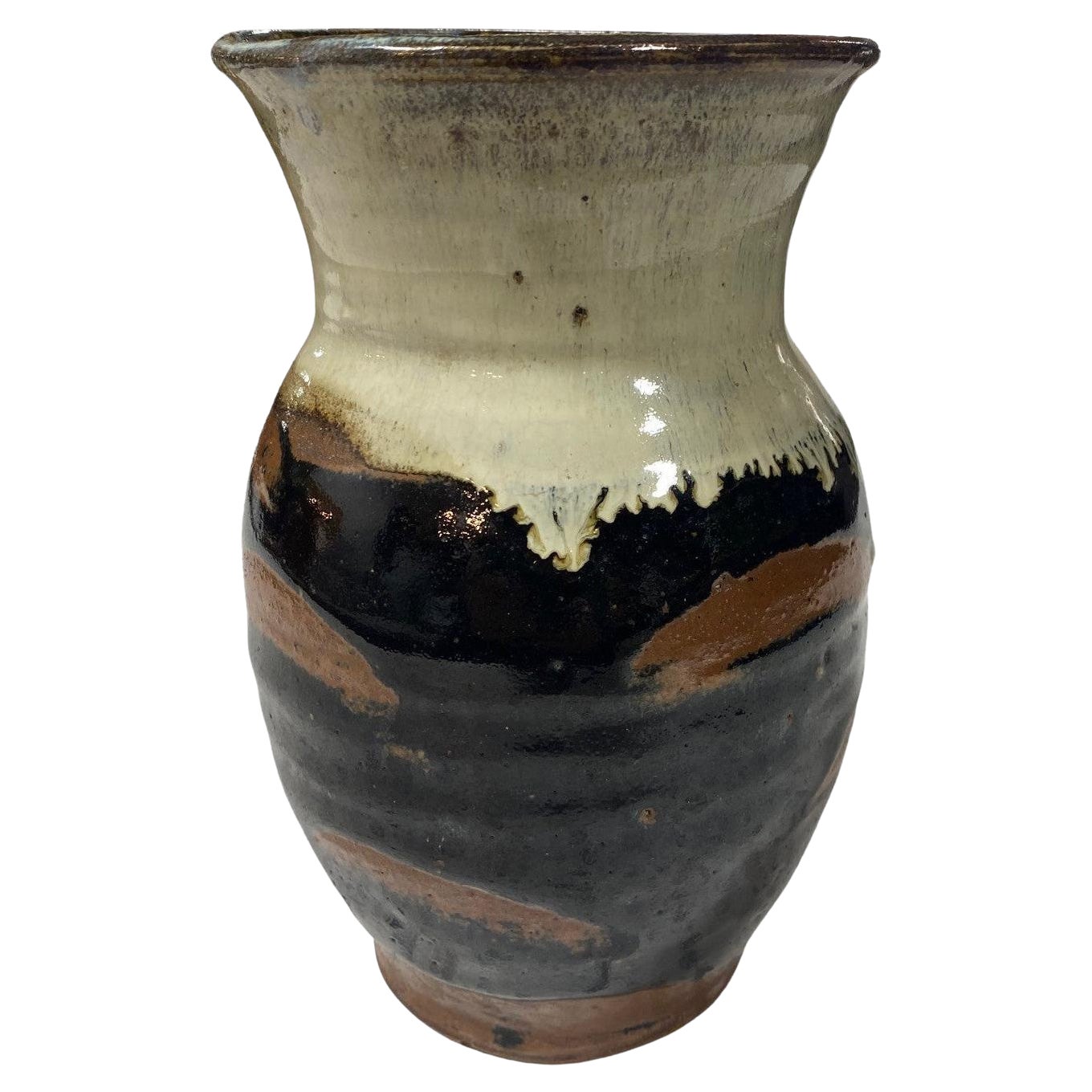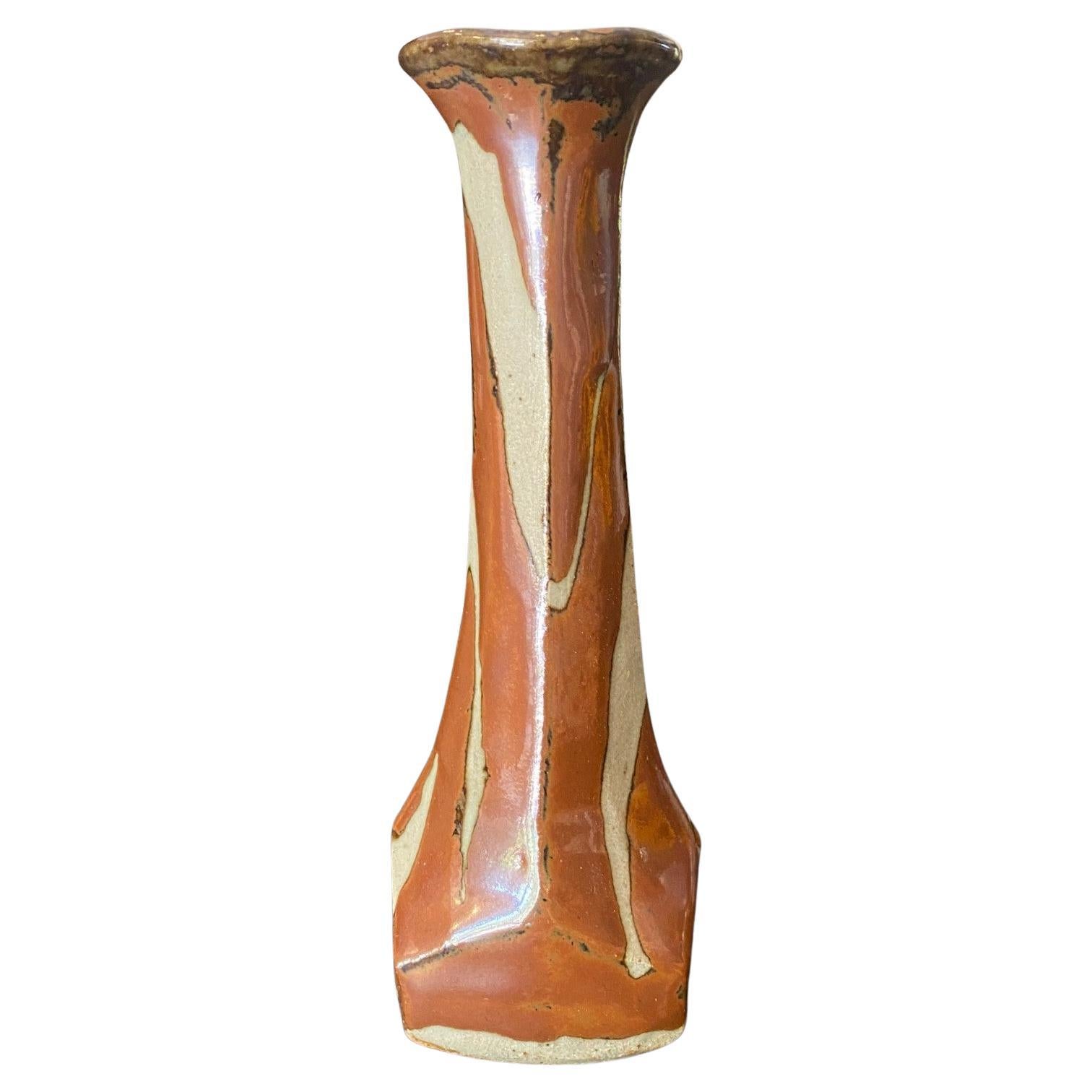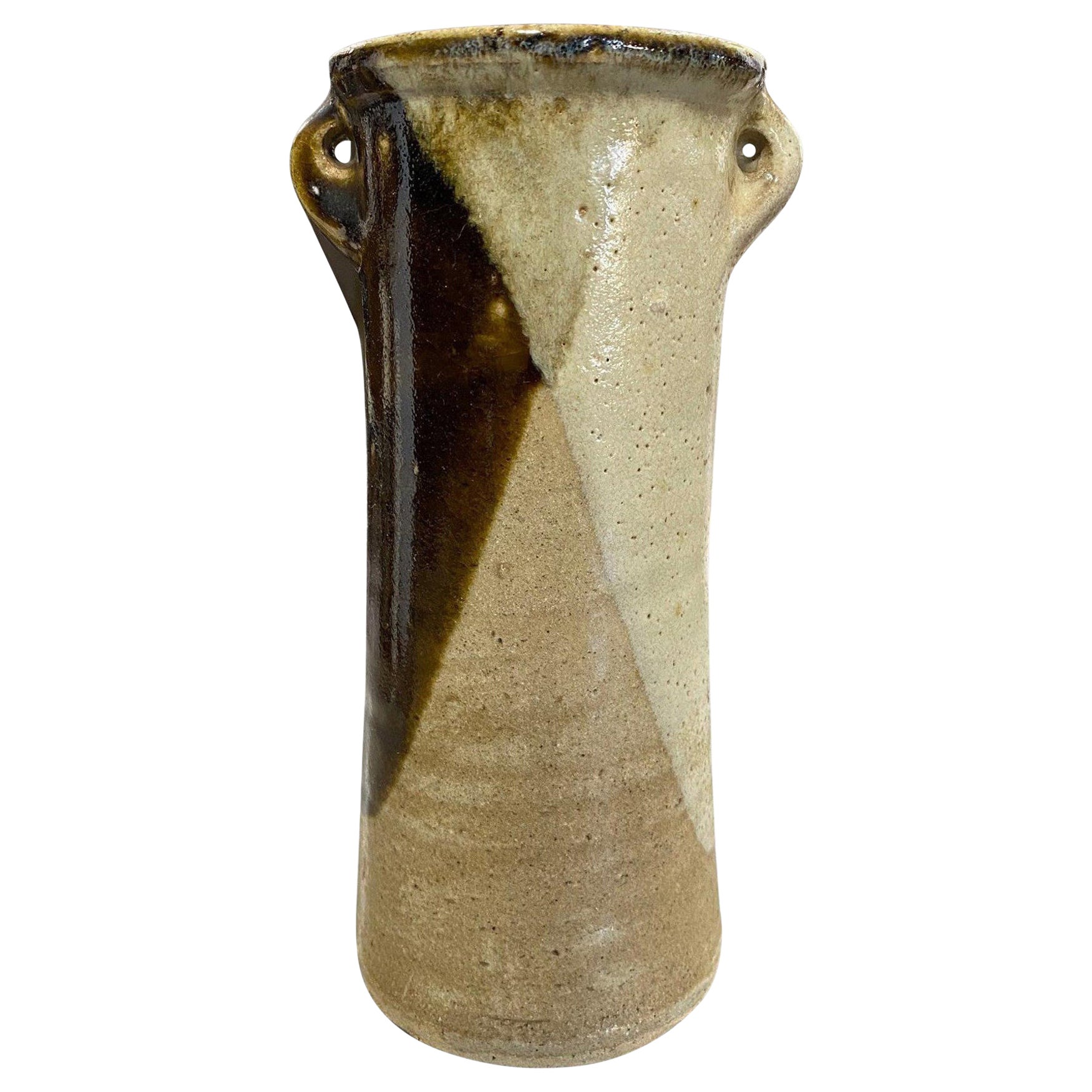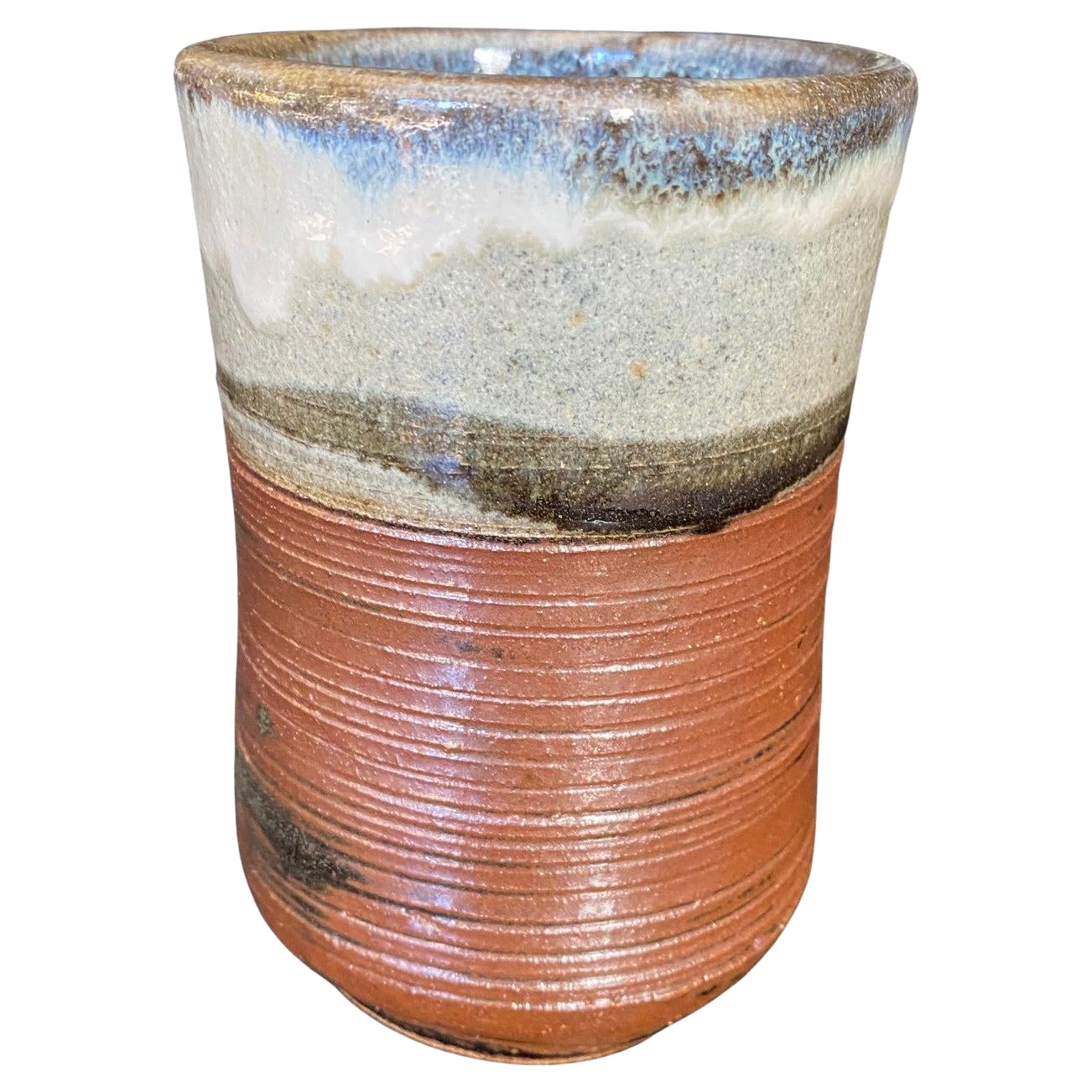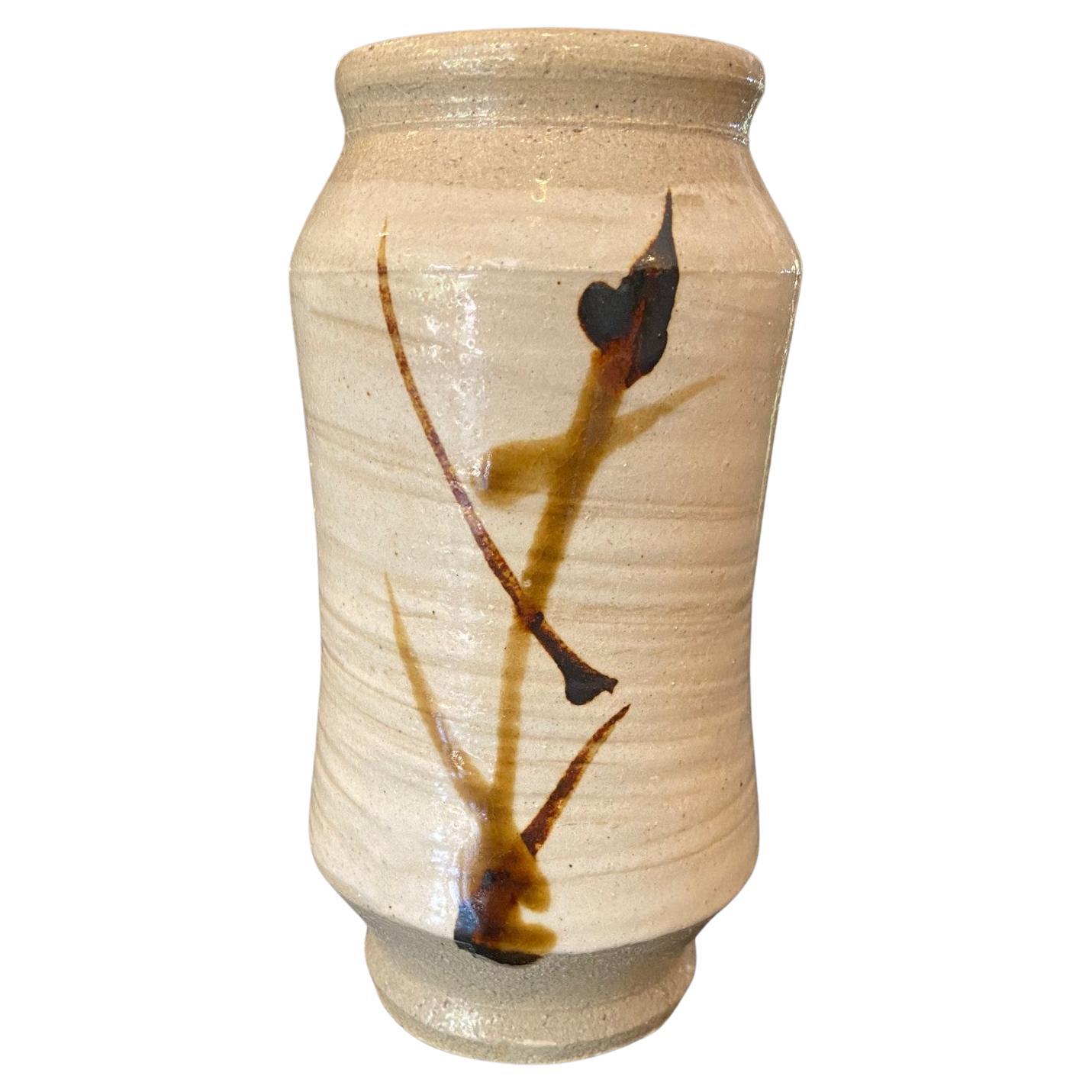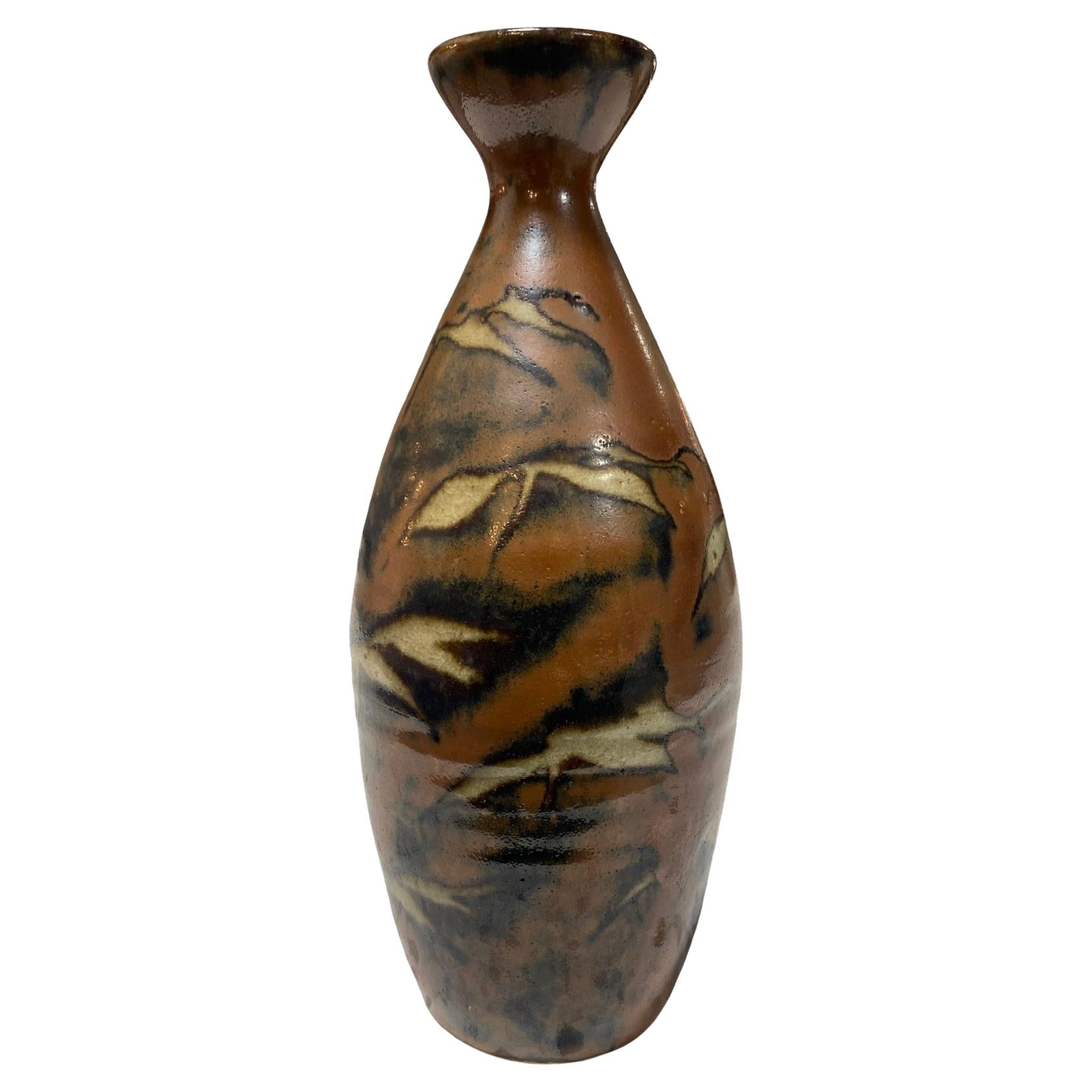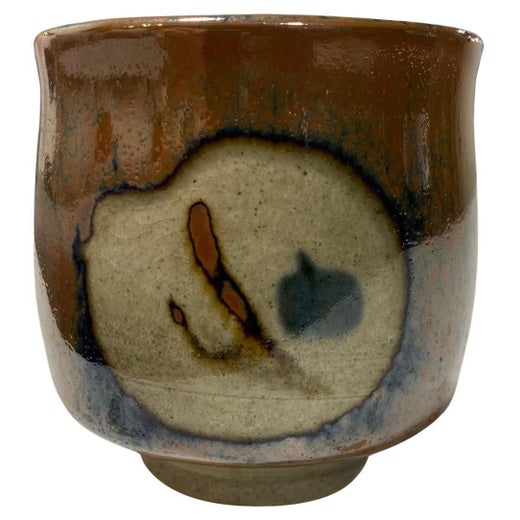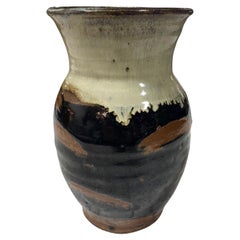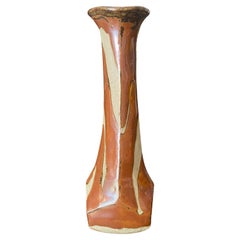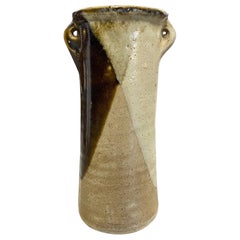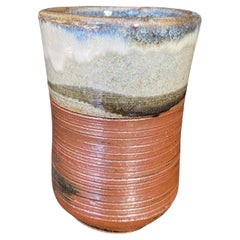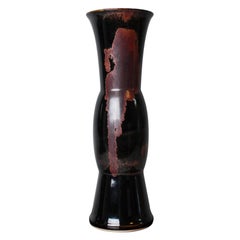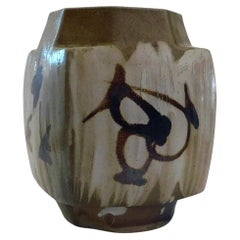Items Similar to Shoji Hamada Tenmoku Glaze & Kaki Trailing Vase with Original Signed Sealed Box
Want more images or videos?
Request additional images or videos from the seller
1 of 21
Shoji Hamada Tenmoku Glaze & Kaki Trailing Vase with Original Signed Sealed Box
$3,450
£2,615.57
€3,015.07
CA$4,858.77
A$5,388.02
CHF 2,831
MX$65,832.42
NOK 35,419.72
SEK 33,247.46
DKK 22,508.05
About the Item
An exquisite, beautifully crafted Japanese pottery vase by master potter Shoji Hamada featuring Hamada's famous signature tenmoku glaze with kaki trailing. The original Hamada signed and sealed wood storage box is included as well as the written appraised signature of his son Shinsaku Hamada. The vase also comes with a printed artist profile/sales brochure of Hamada (featuring some of his other presumably available work). It appears this piece was offered at the Keio Department store in Shinjuku, Tokyo. At first glance, this may seem odd but in fact, this is quite an honor in Japan. This store is known for selling and exhibiting such high-profile artists and potters as Bernard Leach, Lucie Rie, Gyokudo Kawai, Shiko Munakata, Kawai Kanjiro, and Rosanjin Kitaoji. A major goal of many ceramic artists in Japan is to have a one-man exhibition in a department store. For many Westerners, this is a strange concept. Some of the larger department stores have up to three or four dedicated galleries showing concurrent art exhibitions. A well-known artist's exhibition can bring in hundreds, often thousands, of customers to a store and increase revenue for other sales in the millions-of-yen range. These exhibits are usually longer running and highlight a potter's career, like a Living National Treasure such as Hamada.
A beautiful, perfectly balanced piece in pristine, impeccable condition with a very rare combination of signatures and paperwork. This work has a wonderful feel. It would radiate in any Japanese/ Asian ceramics collection or make for an eye-catching stand-alone accent piece in about any setting.
Shoji Hamada was designated a Living National Treasure in Japan in 1955. In 1968 he received Japan's highest artistic award the Order of Culture. His work can be found in collections and museums worldwide including Tokyo’s Japan Folk Art Museum and The Tate Museum, London UK.
Vase dimensions: 8.4" high, 3.5" diameter.
Original signed box dimensions: 10" high, 4.75" wide, 4.75" deep.
- Creator:Shoji Hamada (Artist)
- Dimensions:Height: 10 in (25.4 cm)Width: 4.75 in (12.07 cm)Depth: 4.75 in (12.07 cm)
- Style:Showa (Of the Period)
- Materials and Techniques:
- Place of Origin:
- Period:
- Date of Manufacture:Mid-20th Century
- Condition:The vase is in very good to excellent vintage condition with no discernable flaws, cracks, chips, etc... The box may have light if any wear consistent with age and use (please see photos). Beautiful, unique, and engaging overall.
- Seller Location:Studio City, CA
- Reference Number:1stDibs: LU2254333929912
Shoji Hamada
Shoji Hamada, Designated as a Living National Treasure in 1955, was famed for his return to folk crafts (mingei), establishing the small town of Mashiko as a center of pottery. Hamada espoused simplicity of form in his works, particularly notable in his sugar cane motifs. Hamada strived to reach a style and feeling of innocence through his craft.
About the Seller
5.0
Platinum Seller
Premium sellers with a 4.7+ rating and 24-hour response times
1stDibs seller since 2016
925 sales on 1stDibs
Typical response time: <1 hour
- ShippingRetrieving quote...Shipping from: Van Nuys, CA
- Return Policy
Authenticity Guarantee
In the unlikely event there’s an issue with an item’s authenticity, contact us within 1 year for a full refund. DetailsMoney-Back Guarantee
If your item is not as described, is damaged in transit, or does not arrive, contact us within 7 days for a full refund. Details24-Hour Cancellation
You have a 24-hour grace period in which to reconsider your purchase, with no questions asked.Vetted Professional Sellers
Our world-class sellers must adhere to strict standards for service and quality, maintaining the integrity of our listings.Price-Match Guarantee
If you find that a seller listed the same item for a lower price elsewhere, we’ll match it.Trusted Global Delivery
Our best-in-class carrier network provides specialized shipping options worldwide, including custom delivery.More From This Seller
View AllShoji Hamada Tenmoku Kaki And Nuka Glaze Vase With Original Signed Branded Box
By Shoji Hamada
Located in Studio City, CA
An exquisite, beautifully crafted Japanese Mingei pottery vase by master potter Shoji Hamada featuring Hamada's famous signature tenmoku glaze with kaki finger wipe decoration and a ...
Category
Mid-20th Century Japanese Showa Ceramics
Materials
Pottery, Stoneware
Shoji Hamada Mingei Kakiyu Kaki Persimmon Glaze Vase Original Signed Sealed Box
By Shoji Hamada
Located in Studio City, CA
An exquisite, beautifully crafted, sumptuously glazed vase by Japanese Mingei Mashiko pottery master Shoji Hamada, which features a fine example of his highly coveted rich Kaki/persi...
Category
Mid-20th Century Japanese Showa Ceramics
Materials
Pottery, Stoneware
Shoji Hamada Japanese Earth-Toned Glazed Vase with Original Signed Sealed Box
By Shoji Hamada
Located in Studio City, CA
An exquisite, beautiful flower vase by master Japanese potter Shoji Hamada featuring an example of his popular two-color, sumptuous earth-toned ...
Category
Early 20th Century Japanese Showa Ceramics
Materials
Stoneware
Shoji Hamada Mingei Kakiyu Kaki Nuka Glaze Flower Vase With Original Signed Box
By Shoji Hamada
Located in Studio City, CA
A beautifully crafted Japanese Mingei/ Mashiko pottery vase by master potter Shoji Hamada featuring Hamada's famous signature dripping Nuka glaze over a persimmon Kakiyu Kaki, spiral...
Category
Mid-20th Century Japanese Showa Ceramics
Materials
Earthenware, Pottery
Shoji Hamada Japanese Pottery Mingei Bamboo Tetsue Hakeme Vase with Signed Box
By Shoji Hamada
Located in Studio City, CA
An exquisite, beautifully crafted and designed vase by master Japanese Mingei Moshiko potter Shoji Hamada, a fine example of his iron pigment and glazed hand painted tetsue brushwork...
Category
Mid-20th Century Japanese Showa Ceramics
Materials
Pottery, Stoneware
Shoji Hamada Mingei Kakiyu Kaki Persimmon Glaze Vase Original Signed Sealed Box
By Shoji Hamada
Located in Studio City, CA
An exquisite, beautifully crafted, sumptuously glazed vase by master Japanese Mingei potter Shoji Hamada, which features a fine example of his highly coveted rich Kaki/persimmon glaz...
Category
Mid-20th Century Japanese Showa Ceramics
Materials
Stoneware
You May Also Like
Japanese Ceramic Vase Mingei Style Hamada Shoji
By Hamada Shoji
Located in Atlanta, GA
A heavily potted stoneware vase in cylindrical form, decorated with abstract strokes in iron rust glaze (known as Persimmon Glaze in Japanese) on a black glazed background. The pattern suggests autumn grasses, and it was applied with free hands. The vase is attributed to Japanese potter Hamada Shoji...
Category
Late 20th Century Japanese Arts and Crafts Ceramics
Materials
Ceramic
Ichikawa Kouzan Nabeshima Ceramic Vase with Irresistible Charm
Located in Fukuoka, JP
Captivating Nabeshima ceramic vase by Master Artisan Ichikawa Kouzan. Continuing the legacy of 18 generations of ceramics production since the late 16th century. Patronized by Nabeshima Daimyo, a powerful samurai lord, and renowned for unmatched quality and artistic ingenuity. Passed down with secret formulas for generations. Includes signed wooden storage box.
Dimensions: H.30cm (11.8 inches), W.9cm (3.54 inches)
Weight: 660gr (1.45 lbs) without box, 1.15kg (2.53 lbs) with box
Nabeshima ware is a type of Japanese porcelain that originated in the late 17th century during the Edo period. It was produced exclusively for the Nabeshima clan, a powerful feudal lord...
Category
Mid-20th Century Ceramics
Materials
Ceramic, Porcelain
Shoji Hamada Important Studio Vase - circa 1960's
By Shoji Hamada
Located in Phoenix, AZ
An exquisite, beautifully crafted tall Mingei vase by master Japanese potter Shoji Hamada.
A rare find due to its size and impeccable condition. Measures 8...
Category
Mid-20th Century Pottery
Materials
Clay
Japanese Sumida Gawa ceramic vase
By Sumida Gawa
Located in Autonomous City Buenos Aires, CABA
Sumida Gawa Japanese ceramic vase
Sumida Gawa Japanese ceramic vase decorated in relief with three ladies, two of whom are servants, with a lattice in the centre and an iridescent ef...
Category
20th Century Japanese Japonisme Vases
Materials
Ceramic
Japanese Artist Made Glazed Pottery Vase
Located in Bridgeport, CT
A well made and understated UlGlazed pottery vase having baluster form in a dark glaze and accentuated with relief brown, rust and golden/coppery elements. The vase is artist signed ...
Category
20th Century Japanese Mid-Century Modern Ceramics
Materials
Pottery
Japanese Studio Ceramic Vase by Ken Matsuzaki with Original Tomobako
By Ken Matsuzaki
Located in Atlanta, GA
An impressive stoneware bottle form vase by contemporary Japanese studio potter Ken Matsuzaki (1950-) circa 2010s. The solid form takes its cue from Chinese traditional plum vase (Meiping) with raised and swelled shoulder and a small opening, yet it rises from a non-conventional pentagonal faceted base. The extraordinary surface was covered with Yohen Shino glaze in a deep iron hue. Thick white slips were applied in bold strokes to the lower portion of the vase. The abstract pattern calls to mind of the imagery of the iconic ocean waves found in traditional Japanese art. The presence of the vase is strong and none-compromising, reaching back to the past yet appearing utterly modern. It is marked by the artist underneath and comes with the original tomobako with title and author inscriptions and a wrapping cloth with the artist's seal.
"Ken Matsuzaki’s haptic ceramics bring a contemporary approach to traditional Japanese ceramicware, most notably 16th-century Oribe pottery...
Category
21st Century and Contemporary Japanese Modern Ceramics
Materials
Ceramic
